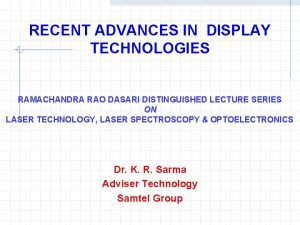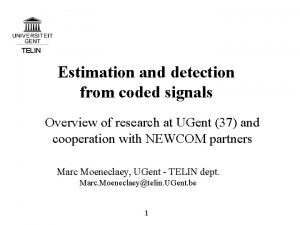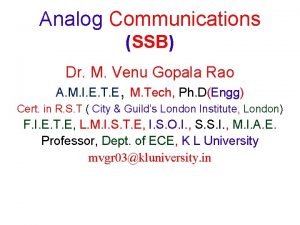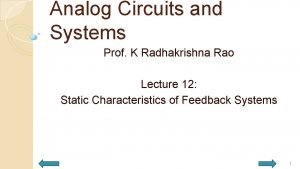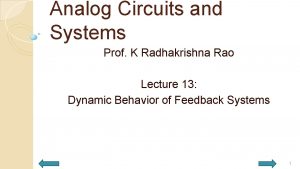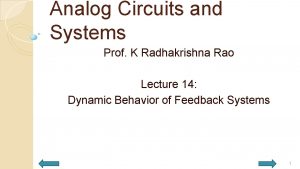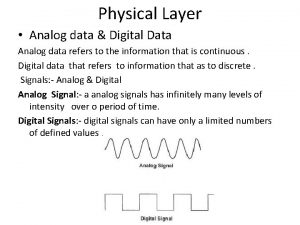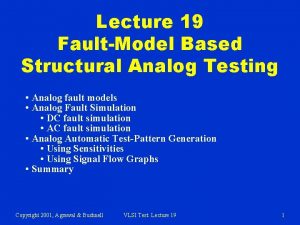Analog Communications Dr M Venu Gopala Rao A






























- Slides: 30

Analog Communications Dr. M. Venu Gopala Rao A. M. I. E. T. E, M. Tech, Ph. D(Engg) Cert. in R. S. T ( City & Guild’s London Institute, London) F. I. E. T. E, L. M. I. S. T. E, I. S. O. I. , S. S. I. , M. I. A. E. Professor, Dept. of ECE, K L University mvgr 03@kluniversity. in

Angle Modulation The phase angle of the carrier wave is varied in accordance with the amplitude of modulating signal is referred to as ‘Angle Modulation’. PM: The phase of carrier wave is varied in accordance with the amplitude of message signal. FM: The frequency of the carrier wave is varied in accordance with the amplitude of the modulating signal

Phase angle and Instantaneous Frequency The instantaneous frequency

Phase Modulation

Phase Modulation The phase of carrier wave is varied in accordance with the amplitude of message signal. Assume where is phase modulation sensitivity constant. • Then the resulting Phase Modulated wave is • In this case the instantaneous angular frequency is given by Hence in PM the instantaneous angular frequency varies linearly with the derivative of the modulating signal.

Frequency Modulation

Frequency Modulation The frequency of carrier wave is varied in accordance with the amplitude of message signal. The instantaneous angular frequency is given by or where is frequency modulation sensitivity constant Then the resulting Frequency Modulated wave is

AM, PM and FM Waveforms

PM and FM Waveforms

Relationship between PM and FM • Equations and show that in both PM and FM, the angle of a carrier is varied in proportion to some measure of m(t). • In PM : Directly proportional to m(t) • In FM : Directly proportional to integral of m(t)

Example 1

Example 2

Single Tone Angle Modulation (PM) Let a message signal

Single Tone Angle Modulation (FM) For a single tone FM Modulation is given by

Brief Summary

Phase and Frequency Deviation

Phase and Frequency Deviation


Narrowband F. M

Narrowband F. M.

Frequency spectrum of Narrow Band Frequency Modulation The time domain expression for NBFM is The frequency spectrum of Narrow Band Frequency Modulation is represented by

Spectrum of AM and NBFM

Phasor Diagrams

Bandwidth of NBFM The time domain expression for NBFM is It resembles the AM signal and hence bandwidth is twice of the message signal frequency


Narrow Band Angle Modulation for Base Band Signal Let a base-band signal represented by m(t) is band limited to ‘W’ Hz

NBFM for Base Band Signal For and where

NBPM for Base Band Signal For , and

Comparison Similarities: • Both have the same modulated bandwidth 2 W, where W is the highest modulating signal frequency. • The sideband spectrum for FM has a phase shift of 900 with respect to the carrier, whereas that of AM is in-phase with the carrier. Differences: • In an AM signal, the oscillation frequency is constant and the amplitude varies with time, whereas in an FM signal, the amplitude stays constant and frequency varies with time.

END
 Dr. m. venu gopala rao
Dr. m. venu gopala rao Dr. m. venu gopala rao
Dr. m. venu gopala rao Telemedicn
Telemedicn Alors entends mon coeur mon esprit qui te loue
Alors entends mon coeur mon esprit qui te loue Venu cheriyath
Venu cheriyath Venu menon md
Venu menon md Je suis venu pour la vie
Je suis venu pour la vie Jsus
Jsus Dr. talluri. manmadha rao
Dr. talluri. manmadha rao S balachandra rao
S balachandra rao Cabang ilmu manajemen
Cabang ilmu manajemen Russell rao distance
Russell rao distance G.v.k. rao committee in tamil
G.v.k. rao committee in tamil Amos rao
Amos rao Rama rao md
Rama rao md Rao
Rao Iv rao
Iv rao Michelle rao
Michelle rao Vallurupalli nageswara rao
Vallurupalli nageswara rao Rao
Rao Paila dean
Paila dean Attilio rao
Attilio rao Amos rao
Amos rao Stanford
Stanford Dr goutham rao
Dr goutham rao Dr.t.v.rao md
Dr.t.v.rao md Dr kv chalapathi rao
Dr kv chalapathi rao Rao
Rao Gayatri rao fda
Gayatri rao fda Ramesh r. rao
Ramesh r. rao Tung hô danh chúa
Tung hô danh chúa
















